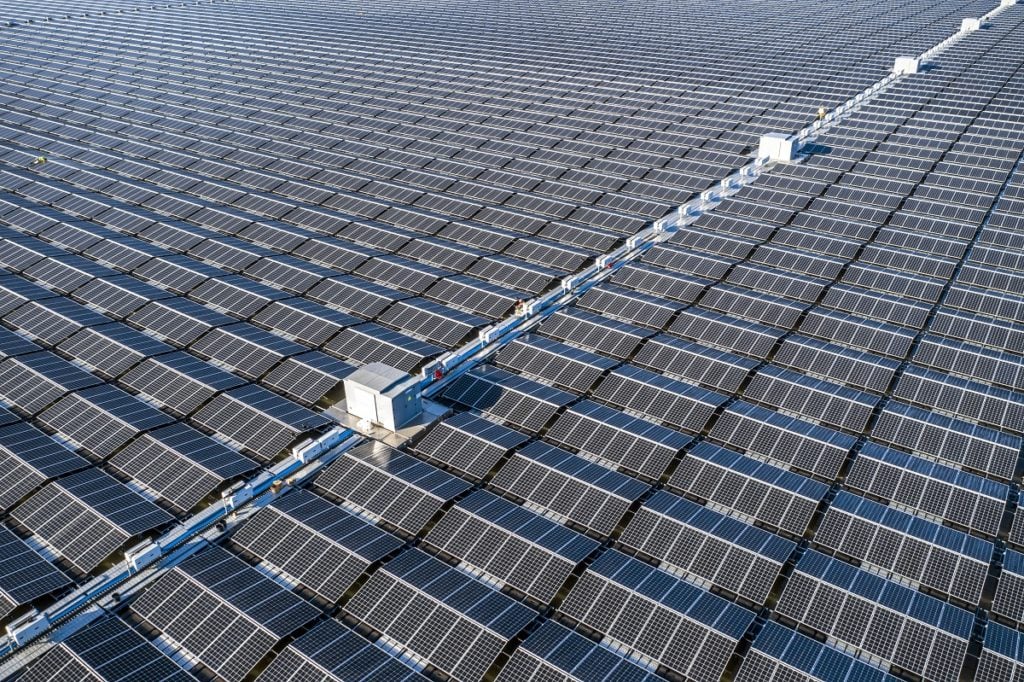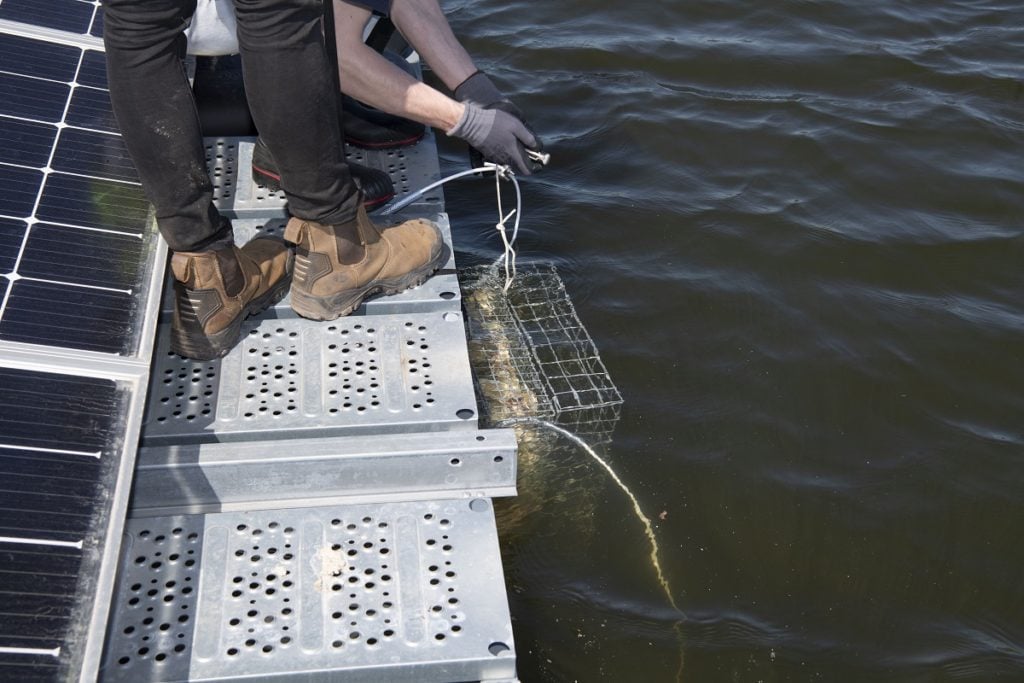
Toni Weigl, head of product management for floating PV at BayWa r.e., explores the current trends for designing and developing floating solar projects and poses the question, where next for floating PV?
Over the years, ground-mounted solar installations have become a familiar sight across the world. Sprawling solar farms and rooftops decked with solar panels are now commonplace. However, as governments and businesses across the globe strive to further innovate and diversify the renewable energy mix – some exciting new PV applications have entered the space.
Unlock unlimited access for 12 whole months of distinctive global analysis
Photovoltaics International is now included.
- Regular insight and analysis of the industry’s biggest developments
- In-depth interviews with the industry’s leading figures
- Unlimited digital access to the PV Tech Power journal catalogue
- Unlimited digital access to the Photovoltaics International journal catalogue
- Access to more than 1,000 technical papers
- Discounts on Solar Media’s portfolio of events, in-person and virtual
One application that is experiencing rapid growth is floating PV, having grown more than 100-fold[1] in the past five years. Resting on large bodies of water, these installations have a number of benefits – not least in helping to avoid land conflict, as many parts of the world become more and more densely populated and less able to relinquish land to ground-mounted solar.
These benefits – amongst others that we will move on to further in the article – are beginning to position floating PV as far more than just a niche contributor to global solar capacity. In a recent report[2], The World Bank noted that worldwide there are around 400,000 square kilometres of man-made reservoirs, suggesting that this new technology has theoretical potential on a terawatt scale. It says, as a conservative estimate, that this could unlock more than 400GWp of floating PV, which is equivalent to the total global installed solar capacity in 2017. It’s estimated that Europe’s contribution alone to this generation total could be around 200GWp, if only around 10% of Europe’s man-made freshwater reservoirs would accommodate floating PV.
In August 2021, the IPCC published the world’s largest ever report into climate change, setting out the stark reality for the state of the planet. Whilst there isn’t a silver bullet for changing the trajectory of global warming, now is the time for economies and organisations across the world to consider new and evolving possibilities for the renewable energy mix. Floating PV is certainly one of those possibilities, but what are the challenges it faces and how can we overcome them to help further grow the technology’s potential across the globe?
The many advantages of floating PV
This brings us to the sprawling advantages of floating PV. One of its biggest benefits, is that it can make an important contribution to the green energy revolution while diffusing debates around land usage. This is particularly beneficial in countries or regions where high population density increases pressure on the availability of land. Many expanses of water offer significant surface areas which are not used for any purpose (like disused mining or mineral extraction lakes) or can be combined with floating PV (like water storage or irrigation reservoirs).
Of course, if the water surfaces do serve another purpose like human recreational activities or as important habitats for animals, those lakes are not to be considered for floating PV, but the remaining water surfaces still present a huge untapped potential. Decommissioned open-cast mines and quarries, gravel pits, reservoirs and aquaculture ponds are all suitable water surface sources for floating PV installations. In addition, compared to other renewable energy technologies, floating PV offers comparatively fast and easy installation and maintenance.
The Cooling Effect
While this is still a relatively new technology, it’s already clear that floating PV can also offer potentially higher yields than its ground-mounted equivalent, thanks to the water-cooling effect. The anticipated potential extra yield of 2-3% in the Netherlands where floating PV is already being employed in Europe, may not seem hugely significant – but over a lifetime of 25 or more years that is a lot of energy and every percent of extra gain makes a huge impact. Furthermore, it is an early sign of its global potential particularly in warmer climates that will benefit from the water-cooling effect even more.
Surface shade and water cover
A further benefit is that as solar panels provide both surface shade and water cover, they reduce water evaporation and limit the impact of wind and waves on the banks. Water quality is also improved as the panels discourage the growth of certain algae. In countries where water shortages are becoming of increasing concern, the evaporation-reduction feature of floating PV installations can be particularly advantageous. It’s worth noting that according to professor Eicke Weber, former director of the Fraunhofer Institute for Solar Energy Systems, more water evaporates from reservoirs than is consumed by humans!
Perfect partnership with hydropower
The existing electrical transmission infrastructure located at hydropower sites, such as dams, means floating PV and established hydropower operations can make great partners. The floating PV park could benefit from the electrical infrastructure of the hydro power plant while it is reducing the waters evaporation leading to higher yields for the hydro power plant. The combination of the two energy sources can also help the dams’ operator manage water levels or to use the dam simply as a huge battery. According to the World Bank report, where floating PV is deployed on large hydropower sites: “The solar capacity can be used to boost the energy yield of such assets and may also help to manage periods of low water availability by allowing the hydropower plant to operate in ‘peaking’ rather than ‘baseload’ mode.
The benefits go both ways: hydropower can smooth variable solar output by operating in a ‘load-following’ mode. Floating PV may therefore be of particular interest where grids are weak, such as in Sub Saharan Africa and parts of developing Asia.”
The challenges
Yet, with every emerging technology – challenges exist to slow down its success and viability as a positive force on the climate. From water contamination and salt levels being too high and impacting implementation, to costs, technical challenges and a lack of societal support – floating PV has come up against a number of issues. However, the first step is identifying the challenges.
Societal support
Often local-level objection halts global enhancement. NIMBYism and community understanding can sometimes greatly delay the execution and completion of the project. For a project to be implemented, planners must be granted a permit – and this can be a challenging topic.
The first issue surrounding permits is – at times – a distinct lack of understanding surrounding which permits are actually needed for the operation of floating PV installations. Specific regulations addressing permitting or licensing, and legal interpretation is required in each country, but sometimes they do not exist or are not fully formed. Sometimes (i.e. in Germany) even within a country the framework is different in each region and the interpretation is different between lawyers and local authorities. Nor are there any universal standards surrounding water rights, electrical connections, construction requirements or energy/water company permits.
Therefore, even if what appears to be a very safe and effective project is presented to the authorities, a lack of understanding of what constitutes ‘meeting the standards’ for implementation, means authorities often have difficulties to approve it to go ahead.
Of course, it is only expected that local authorities and residents may question how the implementation of floating PV will impact on their quality of life and the quality of their natural environment. Before any installation takes place, it’s important that floating PV can integrate into the landscape on an aesthetic and practical level. Floating PV arrays do not have a high visual impact as they are more likely to blend in with the surface water where they are located. Nevertheless, community outreach and alignment are vital in ensuring Floating-PV makes a positive impact on the local environment and population. Ahead of a project’s construction, many information evenings, personal discussions and feedback opportunities can be organised with local residents and associations to ensure a collaborative approach to the project. Neighbours to BayWa r.e.’s Tynaarlo floating PV park are testament to this. Community funds can also been set up to promote ongoing sustainable activities and investment in the local areas.

This is also the case for the general implementation of renewable energy technologies, particularly in light of the ever-worsening climate crisis that the world faces. Solar and wind solutions can generate more power from the same footprint than ever before. However, we are increasingly seeing that the pace of innovation is moving faster than local policy allows. It is a race against time, and to help implement projects at a faster speed, governments, businesses and policy makers must focus on local education and collaboration with communities to overcome legislative barriers and gain community trust. This kind of education – alongside education about protecting the environment generally – could begin at a school age to help educate children about climate change and the technologies that exist to combat it.
Economic viability
Clearly, investment and cost of capital are important considerations when applying any technologies, especially relatively new ones. But while installation costs for floating PV are currently slightly higher than those for ground-mounted solar, it is anticipated that these will fall fairly quickly as the technology matures and production rates increase.
Even in the shorter term, it is important to note that higher yield from water cooling effect, reduced O&M costs and quick installation balance out the higher initial investment costs that are needed. The huge water surface areas available will offer the potential to build much larger power plants, which in turn reduces the specific build costs thanks to economies of scale.
The World Bank’s view is that while this is a nascent sector, there should be sufficient experienced suppliers active in the market to enable developers to achieve appropriate project finance. Several parties, including BayWa r.e., have proven that banks and investors are keen to finance and buy these projects. And once built, operation and maintenance of such floating PV installations is straightforward and cost-effective – providing, of course, that the design and construction has been carried out diligently.
Technology, structure and design
All floating PV needs adequate anchoring and mooring to withstand wind, waves and current – a recurring problem for some of the early projects. Also, depending on the location and climate, individual plants need to be able to withstand additional conditions caused by the surroundings.
Questions of cable duct durability and stability needed to be addressed too, along with identification of the most appropriate materials – plastic or steel – and the choice between east/west or south-facing floating arrays. While the number of suppliers in this sector had previously been limited, many new suppliers have emerged in recent years.
Developers keen to maximise their opportunities in this sector would be wise to draw on the experience of other companies which already have a track record in operating in an aquatic environment. Additional funding and policy support can also help to build up more knowledge throughout the industry.
Ecosystems
Comparatively speaking, little is known about the impact floating PV may have on the environment, however first results from Hanze University of Applied Sciences in Groningen about a BayWa r.e. floating PV park have been published. This independent research[1] found positive results on water quality. Further, BayWa r.e. is working with Buro Bakker / ATKB on an investigation of biodiversity and ecology of floating PV.
According to the water quality monitoring carried out by Hanze University of Applied Sciences, the water quality showed no major differences in the measured key water quality parameters below the solar panels, such as conductivity, temperature or dissolved oxygen. The temperature at the upper layers was only slightly lower under the solar panels, and there were fewer temperature fluctuations detected. The system used in the project, which allows wind and sunlight to easily reach under the panels, was identified as a possible reason for this. When looking at the site as a whole, the researchers found that the water quality below the floating PV farm remained at the same level as the surrounding water surface.
As part of its research into the effects of floating PV panels on water, ecology and biodiversity, they also observed that the presence of the panels leads to less wind activity on the water surface, resulting in less erosion of the banks and therefore protecting and stimulating vegetation. Furthermore, the floating PV park can be additionally equipped with bio huts to further stimulate the growth of the fish population.

After this first year of research, no initial negative effects have been seen. However, multi-year research is required to establish clear results and studies will be ongoing over several years to monitor the long-term effects in detail.
Developers and operators alike will need to consider the impact on ecology, wildlife and marine life – the more this can be measured and recorded, the easier it will be for future installers to demonstrate minimal environmental impact. This will also pave the way for more acceptance and easier, more straightforward permit procedures.
What’s next for floating PV?
The benefits of floating PV are clear. In a world that is becoming more densely populated by the second, land is scarce and with the climate challenge racing towards us, we need new options for generating solar power. Whilst the technology still has many ‘unknowns’, initial research shows that floating PV does not have a negative impact on the environment. However, this research must continue.
Although capex costs are still a bit higher in comparison to other solar technologies, these are anticipated to fall as technology advances. There’s also a small but growing pool of suppliers and developers with the expertise to achieve commercial project finance, which will in turn help to increase uptake.
As floating PV continues to evolve, it will become a technical and economical option that is complimentary to ‘standard’ PV systems. Thanks to the falling cost and increased understanding of the benefits of the application, the future of floating PV is bright. The global expansion of floating PV will serve as an important contribution to the green energy revolution without competing against other uses for land.
There is excitement around floating PV, and for good reason. At BayWa r.e. we see the vast potential, and encourage others to do so too. Our goal is to implement a further 500MWp of floating PV projects by 2025, and by 2030 we hope to be able to also build them in more challenging environmental conditions like offshore.
References
[1] Nan Zhang, 2020, Nano Technology, Volume 77
[2] World Bank Group, 2018, Where Sun Meets Water: Floating PV Report, Volume 1
[3] Talal Yusaf, 2021, “Sustainability”, 13 (11), 6421
Author
Toni Weigl has been dedicated to photovoltaics since 2008 with a strong background in electrical and mechanical engineering from his M.Sc. in Power Engineering from the TU Munich. He worked in various PV related environments. In 2018, Toni joined BayWa r.e. Solar Projects as a project manager. He is now head of product management floating PV, driving forward the global expansion of FPV within BayWa r.e.







